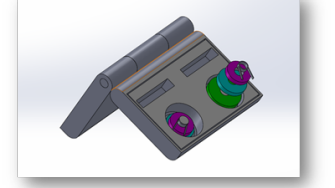Streamlining fitness equipment: UNSW students design modular barbell
UNSW Students have designed a modular barbell in collaboration with Rebel Sport for increased shipping and storage efficiency.
UNSW Students have designed a modular barbell in collaboration with Rebel Sport for increased shipping and storage efficiency.

A team of nine undergraduate students from the UNSW School of Mechanical and Manufacturing engineering have collaborated with Celsius, Rebel Sport’s gym equipment brand, to create a new type of barbell. The final design is a modular barbell, which is easier and cheaper to ship and requires less storage space for the end user, without compromising on quality or loading capabilities.
The project was chosen by the students for their group Thesis course (Thesis A MMAN4010 / Thesis B MMAN4020 / Project A MMAN9001 / Project B MMAN9002). The project was facilitated by Dr Shaun Chan, and the course was coordinated by Dr Wade Smith and Professor Tracie Barber in 2022.
During the COVID period, delivery became a game changer for every business doing online transactions. Sales of fitness equipment for at home use skyrocketed, and shipping became a significant issue for Rebel Sport. As their existing barbell could not fit into one box with all the weight plates, they were faced with shipping issues and an increased risk of losing parts, which was reflected in their customer reviews. A modular barbell could mitigate these issues.
“We had seen a few competitors doing a modular barbell, but we were quite hesitant to go down that path, as we didn’t want to downgrade the quality of the product. We found that the competitor’s products were actually not great in terms of quality. So that’s when we thought: there is an issue and an opportunity here. Let’s get an expert view on this,” says Matthieu Germain, Business Manager at Rebel Sport and mentor of the thesis project.
Rebel Sport asked the UNSW team to review what the competitors were doing and propose a reliable option that performed as well as the current one-piece barbell, according to tests and reviews of the current market.
“We had to ensure that the product had the same loading capabilities as a full piece barbell. We also needed to look into threading, which was known to create some splintering with use. Other than that, we were free to explore any options. We were working closely with Matthieu to ensure that we were producing something that Rebel Sport was going to be happy with,” says Tom Champion, final year student Mechanical and Manufacturing Engineering, and team leader.
The team consisted of nine students and was mentored by Yuwan Huang, PhD candidate at UNSW Mechanical and Manufacturing Engineering.
“We weren’t all able to meet face to face, which made it challenging to keep track of what everyone was doing. We decided to split up into three subgroups. The first group was doing the Finite Element Analysis (FEA) testing, which is simulating what using the barbell with weights would look like, as well as the physical testing of the barbells to validate the FEA. The second group focused on surface treatment and the third on the shipping compartment,” says Tom Champion.
The team’s final design consists of three pieces: two side bars with a male thread and one central bar with female thread.
The initial Rebel Sport barbell featured sleeves with spinlocks which were threaded, which is a region where splintering could occur. The team recommended an alternative blocking mechanism with clamps, and an electroplated chrome finish.
The side bar, the middle bar and the clamp locks.
The shipping compartment’s design consists of a cardboard leather box, 8 EPE pearl cotton corner protectors, protective packaging foam and a plastic box. The box transforms to a self-standing weight plate holder with a plate locking mechanisms. This allows users to easily take out the plates and barbell without having to open and close the box with each use.
The shipping compartment transforms to a self-standing plate holder.
“We have worked with UNSW students several thesis projects since 2017, and I have to say this was a particularly good one. This team has done an amazing job in terms of managing the project, understanding the brief and rewording it in a way for them to execute it well,” says Mr Germain.
“Now we know that we are able to design modular barbells, we can consider the design in a commercial sense: is this something the customer could accept and understand? Then we can decide whether we push forward the idea and actually industrialise it,” he says.
The team’s efforts were awarded with high grades, ranging from an 81.5 to an 88.2.
“As the team leader I learned a lot about leadership as well as the importance of communication, having weekly meetings with all stakeholders. I had not been exposed to Finite Element Analysis before, and it was very interesting to hear more about that group’s results,” says Tom Champion.
“I really enjoyed applying the knowledge I learnt in my courses into real practice. I also improved my communication and cooperation skills, as sometimes we disagreed on how to solve a specific problem,” says Panyang Xiang, final year student Mechanical and Manufacturing Engineering.
“I’ve really seen the team improving and progressing. This project is going outside of their expertise, as they are facing a real client. The students need to apply their expertise in a way that is understandable by someone who is not an expert in the area,” says Mr Germain.
“That is the difference between university and real life: in real life you are employed for the expertise you have, but you don’t need to demonstrate it in an academic way on a daily basis. You have to understand the value and the outcome, which is something more concrete. To see these students reflecting on that journey was very interesting,” he says.

Tom Champion, Samuel Beedham, Sean Chen, Panyang Xiang, Ruifeng Zhang, Jinquan Dong, Zongheng Huang, Erika Lo and Kevin Silva.